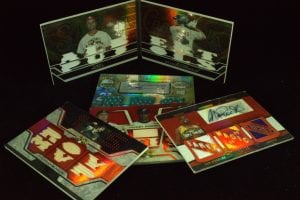Precision Work Enables Topps Company to Offer Intricately Designed Sports Cards to Collectors
Since its inception as a family business for tobacco and then chewing gum, The Topps Company Inc has remained dedicated to being at the ‘top’ of its market.
Staking a Claim with Sports Hobbyists
It was 1949 when Topps started to focus on fostering an enduring connection between sports’ fans and their heroes by creating intricately designed collectibles. Topps staked its claim with hobbyists by offering 252 Magic Photo Cards featuring sports stars of the day.
In 1951, Topps became a permanent fixture with American sports by releasing its first series of the modern baseball card. The first annual series of baseball cards came the following year when the trading card market exploded.
By the late 1980s, Topps continued to find new ways to make its cards more unique and appealing to savvy baseball card collectors and remained at the forefront of the market.
Seeking Best Precision Partner to Enable Piece-of-Game Collectibles
By the 1990s, baseball cards had gone far beyond color photos on cardboard sheets cut into 132 cards. Topps wanted to offer fans a literal piece of the game, setting bits of memorabilia or relics onto card fronts. To increase rareness, they also needed a convenient, consistent way to produce special cards in smaller ratios to its standard print runs.
Topps turned to QC Precision Machining for the tools and procedures to manufacture these unique products.
“QC’s rout process enables us to cut various elements on the front of each card,” says Tom, Topps’ director of quality and manufacturing. “We really didn’t have this capability until we began working with them.”
Enabling Uniqueness in Any Quantity
QC has the capability to machine cards in any quantity – from one to thousands – increasing the end-use value of the card to the consumer. QC also has the capability to “Break the Mold” which is to actually take the plate that printed the card and engrave the logos and names, as well as enclose memorabilia/relics to the construction of the card. Relics can be pieces of the game, including worn or used jerseys, bats, balls, and gloves.
“We can now give Red Sox fans their own piece of Fenway Park’s Green Monster,” says Tom.
Being the Only One in the World
The talented staff at QC Precision Machining and partners with Topps’ designers to engineer how a card will be laid out on the huge sheets, which are cut down to fit QC’s setup. The cards are printed and packaged at different locations throughout the United States.
Recasting Made Easy
QC makes it easy for Topps to recast a card into multiple products. A card for Red Sox pitching star Daisuke Matsuzaka, for example, can have a Triple Relic, encasing bits of baseballs he threw in spring training games.
The ability to easily produce high-end cards has made Topps a smash on eBay – where Topps offers exclusive sets for the online market.
According to Tom, QC’s rout process is what adds the most value to Topps’ products.
“Traditional methods don’t provide the intricacy of the cuts or the ability to make changes,” he says. “Before QC, we could do some things with laser cutting, but it was tedious and its use was limited.”
Remaining Ahead of the Competition
With QC Precision Machining as a partner, Topps seems to have no limits. QC gives Topps the technology to sell a wider variety of increasingly intricate cards – which range in price from $1.99 a pack to $250. This partnership helps Topps be the leader in the industry.


